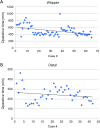Outcomes associated with robotic approach to pancreatic resections
- PMID: 30505596
- PMCID: PMC6219977
- DOI: 10.21037/jgo.2018.08.04
Outcomes associated with robotic approach to pancreatic resections
Abstract
Minimally invasive techniques have improved post-operative outcomes, however, the majority of pancreatic surgery, known for its complexity, is still performed via open approaches. The development of robotics has improved dexterity which may allow for application in more complex surgeries. We queried a prospectively maintained robotic database to identify patients who underwent robotic pancreatic resection by a single surgeon between 2012 and 2016. Patient demographics and operative outcomes were compared using Mann-Whitney U, Kruskal Wallis and Pearson's Chi-square test as appropriate. We identified 119 patients; 65 Whipples [Robotic Whipple (RW)], 43 distal pancreatectomies, 4 total pancreatectomies, 6 pancreatic enucleations, and 1 robotic cyst gastrostomy with a median age of 71 [24-91], median body mass index (BMI) of 27.6 (16.8-40.2), and American society of anesthesiologists (ASA) of 3. The median estimated blood loss (EBL) was 125 [25-800] and loss of heterozygosity (LOH) 6 [1-34]. Mean operative time for RW decreased after 15 cases (578 vs. 457 minutes, P<0.004). Conversions to open occurred in 5 (4.2%) patients. In total of 117 (98.3%) patients underwent R0 resections and the median lymph node (LN) harvest was 16 [0-37]. The 30 and 90 days mortality was 1 (0.8%). Major complications (Clavien-Dindo grade 3-5) were seen in 16 (13.4%) cases (20.3%) but decreased steadily as volume increased (case 30). Pancreatic leaks occurred in 14 (11.8%): A, 8 (6.7%); B, 4 (3.4%); and C, 2 (1.7%). Robotic assisted approaches to pancreatic resections is feasible. However, it takes approximately 15 cases before a decrease in operative time and 30 cases before major complications are decreased. These trends in complications are associated with surgeon experience and volume are critical to consider in robotic pancreatic surgery.
Keywords: Robotic; Whipple; distal pancreatectomy; pancreatic resection.
Conflict of interest statement
Conflicts of Interest: The authors have no conflicts of interest to declare.
Figures
References
LinkOut - more resources
Full Text Sources



